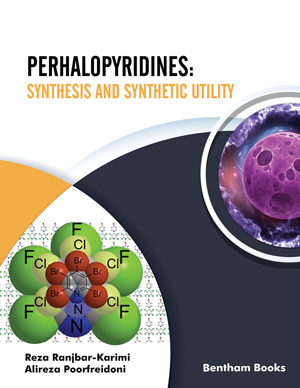Abstract
Pentabromopyridine is prepared from 4-hydroxypyridine via two pathways. Pentabromopyridine is less active than pentachloro- and pentafluoropyridine toward nucleophilic attack. Its nucleophilic reaction is affected by the hindrance of the bromine atom. Oxidation and methylation of pentabromopyridine give pentabromopyridine-N-oxide and N-methylbromopyridinium salt. Metal-halogen exchange between pentabromopyridine and n-butyl-lithium or magnesium give tetrabromo-4-pyridyl-lithium and tetrabromo-4-pyridylmagnesium bromide. 2,4,6- tribromo-3,5-difluoropyridine is obtained from the bromination of pentafluoropyridine in the reaction with nucleophiles at the C-F bond. Cross-coupling reactions of 2,4,6- tribromo-3,5-difluoropyridine and 3,5-dibromo-2,6-dichloropyridine produced arylated and alkenylpyridines pyridines.
Keywords: 2, 3, 5, 6-Tetrabromo-4-pyridylamidophosphate Esters, 2, 3, 5, 6-Tetrabromo- 4-pyridylmethylsulfoxide, 2, 4, 6-Triazido-3, 5-dibromopyridine, 2, 4, 6-Tribromo- 3, 5-difluoropyridine, 2, 4, 6-Tris(triethoxyphosphazenyl)-3, 5-dibromopyridine, 2, 6-dichloro-3, 5-dialkynyl-substituted Pyridines, 2-N, N-dialkylaminotetrabromopyridines, 3, 5-Dibromo-2, 6-dichloropyridine, 3, 5-Dibromo-2, 6-dichloropyridine, Lithium–bromine Exchange, Nitrotetrabromopyridines, N-Methylbromopyridinium Fluorosulphonate, Pentabromopyridine, Pentabromopyridine- N-oxide, Suzuki Cross-coupling Reaction, Tetraalkynylpyridines, Tetrabromo- 4-pyridyl-lithium, Tetrabromo-4-pyridylmagnesium Bromide, Tetrabromopyridine- 4-sulfenyl Chloride, Tetrabromopyridine-4-thiol.






















